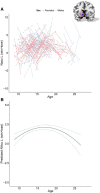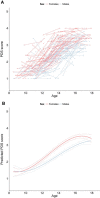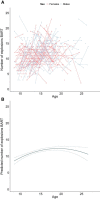Longitudinal changes in adolescent risk-taking: a comprehensive study of neural responses to rewards, pubertal development, and risk-taking behavior
- PMID: 25948271
- PMCID: PMC6605271
- DOI: 10.1523/JNEUROSCI.4764-14.2015
Longitudinal changes in adolescent risk-taking: a comprehensive study of neural responses to rewards, pubertal development, and risk-taking behavior
Abstract
Prior studies have highlighted adolescence as a period of increased risk-taking, which is postulated to result from an overactive reward system in the brain. Longitudinal studies are pivotal for testing these brain-behavior relations because individual slopes are more sensitive for detecting change. The aim of the current study was twofold: (1) to test patterns of age-related change (i.e., linear, quadratic, and cubic) in activity in the nucleus accumbens, a key reward region in the brain, in relation to change in puberty (self-report and testosterone levels), laboratory risk-taking and self-reported risk-taking tendency; and (2) to test whether individual differences in pubertal development and risk-taking behavior were contributors to longitudinal change in nucleus accumbens activity. We included 299 human participants at the first time point and 254 participants at the second time point, ranging between ages 8-27 years, time points were separated by a 2 year interval. Neural responses to rewards, pubertal development (self-report and testosterone levels), laboratory risk-taking (balloon analog risk task; BART), and self-reported risk-taking tendency (Behavior Inhibition System/Behavior Activation System questionnaire) were collected at both time points. The longitudinal analyses confirmed the quadratic age pattern for nucleus accumbens activity to rewards (peaking in adolescence), and the same quadratic pattern was found for laboratory risk-taking (BART). Nucleus accumbens activity change was further related to change in testosterone and self-reported reward-sensitivity (BAS Drive). Thus, this longitudinal analysis provides new insight in risk-taking and reward sensitivity in adolescence: (1) confirming an adolescent peak in nucleus accumbens activity, and (2) underlining a critical role for pubertal hormones and individual differences in risk-taking tendency.
Keywords: adolescence; puberty; reward processing; risk-taking.
Copyright © 2015 the authors 0270-6474/15/357226-13$15.00/0.
Figures







Comment in
-
Reward Processing in the Adolescent Brain: Individual Differences and Relation to Risk Taking.J Neurosci. 2015 Oct 7;35(40):13539-41. doi: 10.1523/JNEUROSCI.2571-15.2015. J Neurosci. 2015. PMID: 26446208 Free PMC article. No abstract available.
References
-
- Akaike H. New look at statistical-model identification. IEEE Trans Automat Contr. 1974;19:716–723. doi: 10.1109/TAC.1974.1100705. - DOI
Publication types
MeSH terms
LinkOut - more resources
Full Text Sources
Medical
